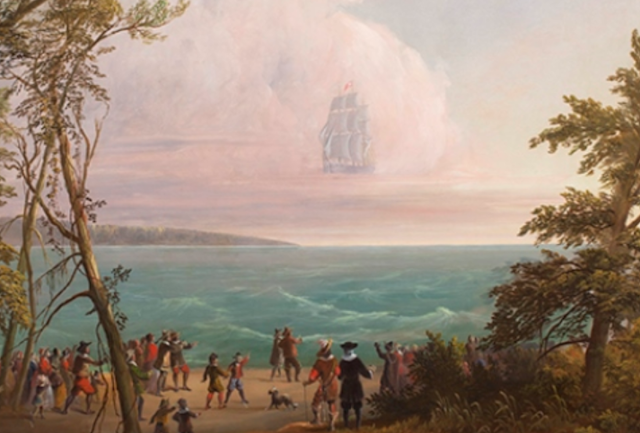The Great Ship of New Haven .
There was once a Great
Ship that had been built in Rhode Island and was bought by the early settlers
of New Haven. The ship was to sail to England and would have carried one hundred fifty tons
of cargo to include everything from lumber, peas, wheat, and beaver skins. The
successful voyage of the Great Ship was critical to New Haven's economic
success.
In January 1646, the Great Ship set sail for England with about one hundred crew members and George Lamberton as its captain. Imagine the colonists hoping that the Great Ship would make New Haven a commercial success, and equally fearing that the dangers of North Atlantic doom the vessel's fate.
That winter, Massachusetts Governor John Winthrop recorded that New Haven harbor was frozen over by ice and a ship passage had to be cut for three miles for the vessel's departure. According to the scholar Patrick Geoffrey, the mid-seventeenth century would see longer winters and more extreme snowfalls. New Haven’s founding thus coincided with what Geoffrey concluded was a Little Ice Age.
As the time passed there
would be no arrival of the Great Ship in England or of Captain Lamberton.
According to historian Ernest H. Baldwin, the loss of the Great Ship was
a major setback to the economy of the colony. The Early New Haven Colony
records seem to suggest that the loss of the Great Ship created increased
tensions in the colony as the laborers who built the blocks for the Great Ship were never compensated due to the colony’s financial
losses.
Then, on an evening in
1647, a powerful thunderstorm came over the colony. The colonists saw a vision
above the harbor in the sky of a phantom ship with Lamberton on the
deck. According to Baldwin, the colonists interpreted this as a divine sign
from God that their friends had been forever lost at sea. Suddenly, the vision
of the ship disappeared behind the clouds. But of course, no known first-hand
accounts of the vision of the Great Ship exist. One of these early accounts is from Winthrop,
who described the ghostly vision, recording in his journal that “there appeared ouer (over) the harbor at New Haven in the
eueninge (evening) the forme of the keele of a Shippe with 3 mastes: to which
were suddenly added all the tackling, sayles, presently after upon the toppoe
of the poope, a man standing with one handle.”
The question remains, where did the first account of this vision originate? A definitive answer may not exist. It is likely that this vision of the ship was passed down through the generations by word of mouth in the manner of all local urban legends. Potentially, this story was started by someone in early New Haven and then the cycle continued. Possibly Winthrop heard the story from someone residing in the colony during his travels.
By the nineteenth century, New Haven's "Phantom Ship" had become the stuff of Romanticism namely in the lines of the imminent poet Henry Wordsworth Longfellow's poem titled simply, “The Phantom Ship.” In this poem, Longfellow depicted the same eerie vision of a phantom ship described by Winthrop: “It was in the month of June, an hour before the sunset of a windy afternoon, when steadily steering landward, a ship was seen below, and they knew it was Lamberton Master who sailed so long ago."
In the Romantic Movement of the nineteenth century the Great Ship was mythologized as an otherworldly message of mortality and fate. But did the colonists really
view a ghostly vision? The answer to this is unknown and will likely be forever unsolved. It is possible that the colonists mistook a cloud
formation as being a ghostly vision. Early Puritans were always looking for
divine signs from God. It is certainly possible that the colonists saw a
strange cloud formation that they could not explain and interpreted it as a
message from God. Of course, we will never know the answer to what the
colonists viewed, or thought they saw, and if they really witnessed a vision of
a Phantom ship. The only thing that is known is that the vision of the Great
Ship remains surrounded in myth and in local New Haven legend to the present. As such, it joins the ranks of so many New England urban legends. Stories like the Great Ship endure because they connect us to a distant time and place, our cultural
heritage, and local history.
 |
| Figure 1: "Vision of the Phantom Ship" by the artist Jesse Talbot, 1850 (Courtesy of the New Haven Museum) |
Baldwin, Ernest H. Stories
of Old New Haven. New York: The Abbey Press, 1903.
Hoadly Charles J. Records
of the Colony and Plantation of New Haven from 1638 to 1649.
Hartford:
Case, Tiffany, and Company, 1857.
Mather, Cotton. Magnalia
Christi Americana. London: Thomas Parkhurst, 1702.
Patrick, Geoffrey. Global
Crisis: War, Climate Change, and Catastrophe in the Seventeenth
Century.
New Haven: Yale University Press, 2013.
Winthrop, John. The
Journal of John Winthrop, 1630-1649. Edited by James Savage, Richard S.
Dunn,
and Laetitia Yeandle. Boston: Harvard University Press, 1996.



Comments
Post a Comment